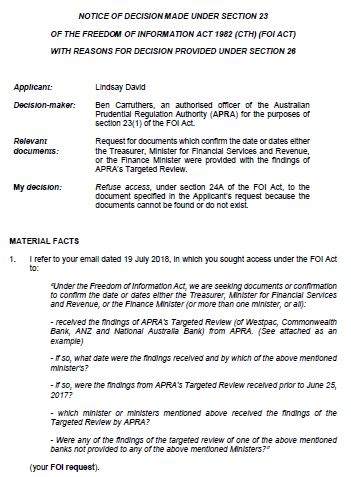More good work from Lyndsay David today as APRA fails to cough up an FOI request:

APRA ordered the “targeted review” in October 2016. It was conducted by PWC for WBC and CBA:
Background
Under its supervisory powers, APRA is able to request banks to commission special purpose (or “targeted”) reviews into topics on which they wish to gain an independent perspective. These reviews are typically performed by the bank’s external auditors with the scope determined by APRA.
On 12 October 2016, APRA issued a letter to the Bank and 4 other large banks requesting that they undertake a Review into the risks of potential misrepresentation of mortgage borrower financial information used in loan serviceability assessments. In its letter, APRA referenced assertions made by commentators that “fraud and manipulation of ADI residential mortgage origination practices are relatively commonplace”.
Having considered in detail the serviceability approaches taken by banks (the last Targeted Review covered this topic), the focus of the Review is on the adequacy of controls in place to ensure borrower information, as used in serviceability assessments, is complete and accurate.
Scope of engagement
In accordance with our engagement letter dated 13 December 2016, we were engaged to perform a controls assurance engagement under Australian Auditing Standard ASAE 3150 Assurance Engagements on Controls, which requires us to evaluate the design and operating effectiveness of controls in place to achieve ten control objectives as stipulated by APRA.
These control objectives are listed in section 1.5 of this report and included controls related to the Group policies and procedures, IT controls, monitoring of control performance and specific controls to verify borrower information in relation to personal details, income, expenses, assets and debts, and to ensure this borrower information is entered into the Group’s serviceability assessment completely and accurately.
The scope of the engagement included controls relevant to Australian residential mortgages originated in the Review Period from 30 September 2015 to 30 September 2016 and included all major origination channels and mortgage products…
The review found that only one in 10 of WBC’s lending controls were operating effectively. The review was never intended to made public but was during the Hayne RC it came to light, via AFR:
An explosive, previously confidential memorandum to the Westpac board last year shows how the nation’s second-largest mortgage lender scrambled to respond to poor results from the Australian Prudential Regulation Authority’s “targeted review” of borrower income and expense verification.
Westpac also fretted it had breached trust with the regulator, after APRA chairman Wayne Byres personally berated the bank as being a “significant outlier” with respect to high risk lending.
“The PwC report has disturbed APRA and there is no easy answer to rebuilding trust with them in this area,” the general manager of portfolio integrity of Westpac’s consumer bank, David Watts, told the board’s risk and compliance committee in the document dated July 29.
So why on earth did APRA not inform any Treasury ministers of the results of the review? The findings were surely explosive enough to do so, as the subsequent Hayne RC has shown in gory detail. By keeping it a secret, APRA protected the banks, left itself exposed, and may have created a liability for the government which left the public at the mercy of the rorts.
I wish I could say that this is out of character for APRA but it has a long track record of highly secretive operations damaging to the public interest.
It’s high time that that secrecy is torched.

